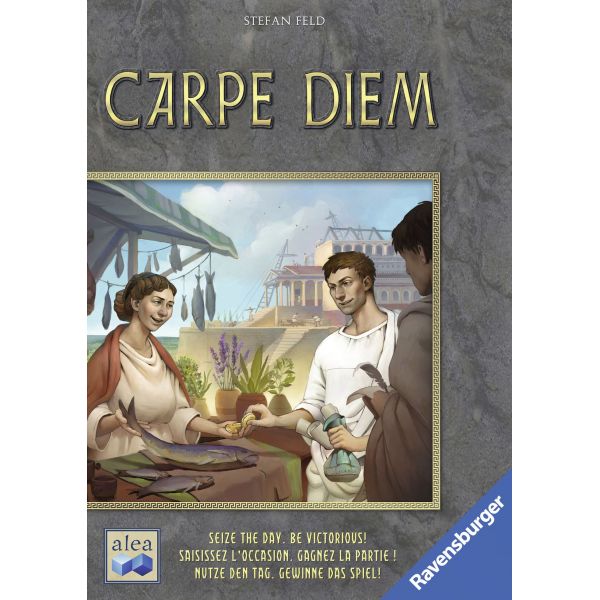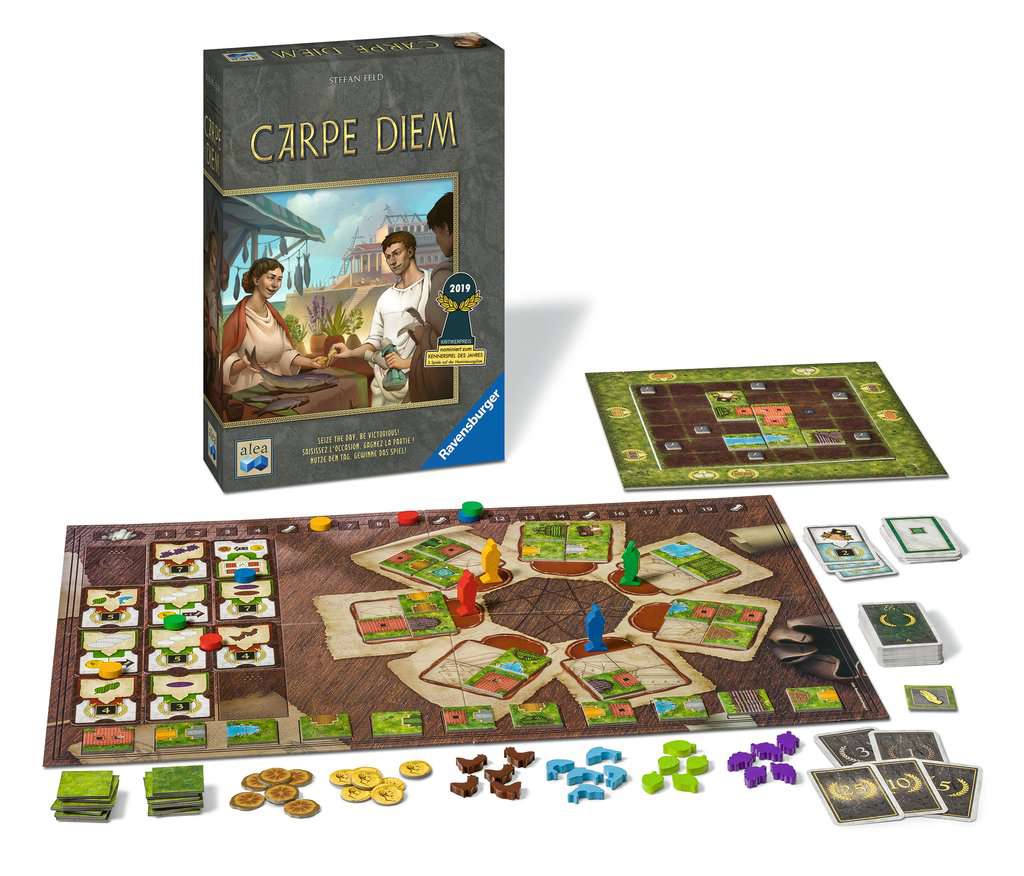Seize the Day by Building the Best District in Carpe Diem

Transport yourself back to Rome in Stefan Feld’s latest award-nominated game, Carpe Diem.
Gameplay
Carpe Diem is a tile placement game for 2-4 players where players are trying to create a district within Rome that awards the most points. Much like many Feld designs before it, Carpe Diem offers many ways to earn points.
The main actions revolve around the 7-sided rondel and randomly placed victory point cards of the shared playing board. Each player will go to a specific area, each beginning with 4 tiles representing the various types of landscape and/or buildings you can use to build up your individual district board (in front of each player). Taking turns, players will draft a tile from the space where they first land, adding it to their district tableau. After taking a tile from the space, players will then have a choice of going to another space connected by one of two paths to their current space. This is but one of the many decisions the game has to offer.
The tiles one collects are also valuable, as landscapes and buildings (once completed) will provide goods, tiles, and/or other opportunities. These goods include fish, fig leaves, and chickens, but also may provide wild materials such as coins or bread. Individual player boards contain randomly constructed borders which offer potential bonuses at specific crossings on the grid, requiring specific buildings to cross those line(s) for endgame victory points. The goods or master tiles generated by completing a landscape or building (and as you can imagine, the bigger the landscape that’s completed, they bigger the yield of goods it will bequeath) will also provide opportunities to score points in between rounds as they fulfil conditions on the victory point cards. Landscapes have tiles that can stretch them to 3-4 lengths, while buildings can never be more than two tiles long.
Tiles work similarly to most tile laying games, where buildings and landscapes of the same type can only be combined, and one most adhere to the borders on the board and building accordingly (for example, a half building cannot be touching the grassy border of the player board nor can two different landscapes be directly connected to each other). There is some strategy to placing tiles. Each player board has an assortment of little scroll tokens. Covering one of them will move players higher up on a banderoll track, which not only will produce an amount of victory points at the end of the game but is relevant to player order during each round. Also, some buildings will offer bonuses beyond materials, such as gaining an extra tile from the row at the bottom of the main board or two movement on the banderoll track.
Placement on the banderoll track is key at the end of the round when it’s time to score the victory point cards. Each round ends when no more tiles can be taken from the rondel (which is determined by the amount of players in any given game), which triggers the scoring phase. During this scoring phase, the player furthest along on the banderoll track will place one scoring token at the intersection of two victory point cards and attempt to score them. Then each succeeding player will likewise place their scoring tokens but cannot place their scoring token in the same area as other players. These intersections will not be able to be scored again for the rest of the game. If you have been hording coins, these act as wildcards to replace any given good represented on a scoring card. If you have been saving up bread, three of them will allow you to fulfill any scoring condition you choose. You can score these cards multiple times. For example, if you place your token at an intersection with one card rewarding points for all completed baker buildings in your district and another that asks for three chickens, if you have two baker buildings and 6 chickens, you could score each of those conditions twice in that round. After scoring, tiles are refilled on the rondel and play continues. After the fourth-round scoring, players will add up all their victory points and the player with the most points wins.

Review
Despite appearances, Carpe Diem is one of Stefan Feld’s easiest titles to pick up and play. The tile laying mechanics are like games such as Carcassonne, so anyone with a bit of working knowledge on such a legendary title will have no trouble with this aspect of Carpe Diem. Likewise, the rondel is easy to see, so players can plot their moves as far as 2-3 turns in advance (providing for a few different strategies). Though scoring can be confusing, especially with how victory point cards are scored and the variable power of certain goods (for example, finishing bakeries will provide players with bread, and bread can act like a wild card good in most scoring situations when it comes to fulfilling victory point card conditions), this adds a depth to the game that many tile laying games lack. A player’s strategy will differ from round to round, and though some long-term planning is necessary when constructing one's district, it's not overwhelming. After a round or two, even the newest board gamer will be able to comprehend how decisions can benefit them both in the short and long term.
Carpe Diem is not all fun and games. The design is very drab (Note: a second edition of Carpe Diem is coming with easier to decipher colors and tiles) and the theme, as it can often be with many Feld designs, feels tacked on. The upcoming second edition of Carpe Diem will have easier to see colors and tiles, but it should be noted that it also reworks the rondel for an even simpler moving method that completely removes the cool factor of the first edition’s moving mechanic.
However, Carpe Diem overcomes many of the poor design choices because the mechanics are smooth, the scoring opportunities plentiful, and there is surprising depth to the choices players can make from round to round — and playthrough to playthrough — without making casual gamers feel under water or hardcore gamers bored. Even with the proposed rondel changes from the first edition to the second, there is still a level of strategy and thoughtfulness to building your district tableau that allows Carpe Diem to provide a next level experience for fans of tile placement games that want to dip their toes into more Euro-style scoring.
Pros: multiple means of scoring, relatively easy to pick up and play despite the overwhelming presentation
Cons: drab design, lacks thematical connection to gameplay, second edition may oversimplify the game’s mechanics




